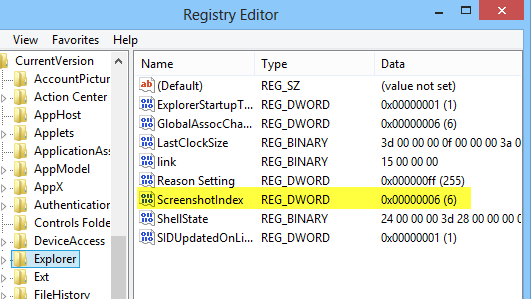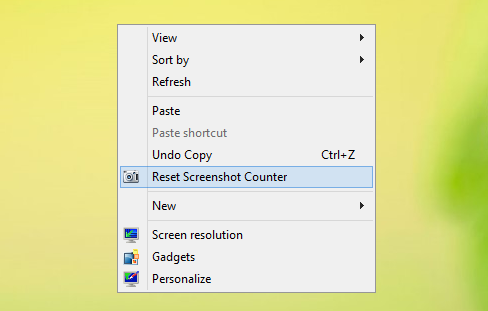Windows 8 has an improved screenshot capturing function that lets you capture a screenshot and save the image to the hard disk in one sweep. This can be executed by pressing the Windows + Print Screen keys together. The screenshots are saved in C:\Users\<username>\Pictures\Screenshots folder with filenames Screenshot (#).png where # indicates the screenshot index counter. Each screenshot you take increments the index counter by one. So far, so good. But it has been observed that the index counter keeps on counting even after you have deleted some or all the screenshots in the folder. Looking at the index counter, thus, one can easily tell how many screenshots you have captured till date.
The screenshot index counter is stored in the Registry. To reset the counter all you have to do is navigate to the following location in Windows Registry Editor and change the index counter.
- Open Registry Editor (press Ctrl+R, type regedit and press Enter).
- Go to this key: HKEY_CURRENT_USER\Software\Microsoft\Windows\CurrentVersion\Explorer
- Inside there is a DWORD called ScreenshotIndex that keeps count of the number of screenshots taken. Right-click on ScreenshotIndex and from the context menu, click Modify.

- Change the value to 1. You can enter any number - the index will start counting from the entered figure. If the number you entered already exist in the Screenshot folder, the next available number will be taken when a new screenshot is created.
Add a Reset Screenshot Counter using Desktop Context Menu
This registry trick was created by Shawn Brink from www.eightforums.com.
Open notepad, and copy-paste the following lines.
Windows Registry Editor Version 5.00
; Created by: Shawn Brink
; http://www.eightforums.com
; Tutorial: http://www.eightforums.com/tutorials/12197-screenshot-counter-reset-windows-8-a.html[HKEY_CLASSES_ROOT\DesktopBackground\Shell\ScreenshotIndex]
"muiverb"="Reset Screenshot Counter"
"icon"="imageres.dll,-57"[HKEY_CLASSES_ROOT\DesktopBackground\Shell\ScreenshotIndex\command]
@="REG ADD HKCU\\Software\\Microsoft\\Windows\\CurrentVersion\\Explorer /V ScreenshotIndex /T REG_DWORD /D 1 /F"
Save the file as .REG. Execute this file and allow Windows to merge the keys to Windows Registry. Right click on the desktop and you should see the Reset Screenshot Counter option.

To remove the Reset Screenshot Counter item from the context menu, delete the following registry key:
HKEY_CLASSES_ROOT\DesktopBackground\Shell\ScreenshotIndex

Comments
Post a Comment